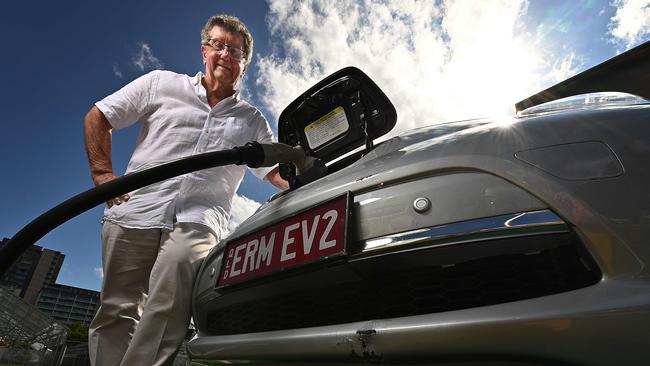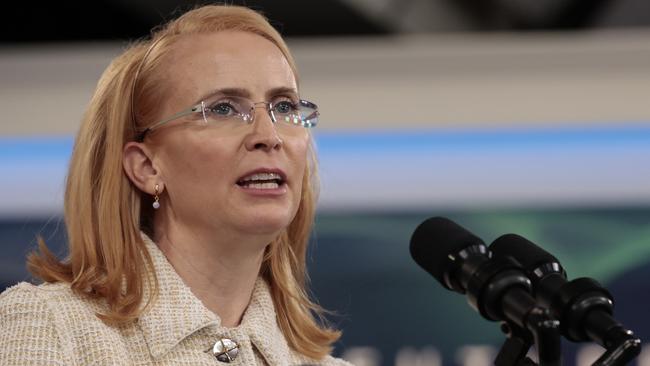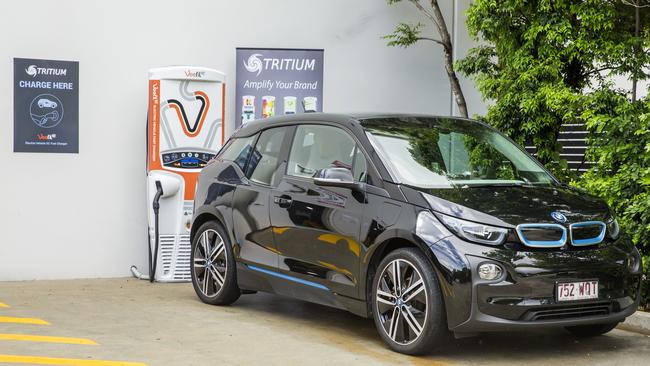The collapse of EV-charging poster child Tritium and why Trevor St Baker thinks it can rise again
EV fast charger Tritium’s debt has blown out to $500m of which $100m is owed to Trevor St Baker, but ahead of Monday’s creditors’ meeting he says he’s optimistic of a rescue package.

Rich lister Trevor St Baker, who alone is owed more than $100m by failed fast-charger manufacturer Tritium, is confident a rescue package for the company will emerge, ahead of a second meeting of creditors scheduled for Monday.
A report on the company’s assets and liabilities, lodged with corporate regulator ASIC in recent days, shows the amount of debt claimed by the company’s creditors has blown out well past $500m, up from a previous reported estimate of $260m.
That in turn was up from an early estimate of $150m.
The company this week said it would not appeal against its delisting from the US Nasdaq tech bourse, which came about after a number of warnings about the company’s shares trading below the required minimum bid price and that there were not enough publicly-held shares to warrant its listing.
A Report on Company Activities and Property (ROCAP) – required as a matter of course when a company is placed in liquidation – lodged in relation to one of the group companies, Tritium DCFC, shows the amount owed to the Commonwealth Bank alone is $262m.
Mr St Baker’s company, Sunset Power, has claimed a debt of $109.7m, while US-based investment firm Ayrton Capital has claimed $40m.
Advisory firms and broking houses also are likely to be significantly out of pocket; McKinsey & Co has claimed a debt of $4.3m, Latham & Watkins $6.9m, JP Morgan Securities $4.1m and Citibank $3.9m.
There are several related-party loans listed in the ROCAP, including $47.7m owed to Tritium Pty Ltd and about $90m owed to US-based DCRN.
A separate ROCAP lodged for Tritium Pty Ltd indicates the group owes money to 296 trade creditors, and $2.2m to “unrelated employees”.
Mr St Baker told The Australian he could not speak on behalf of the company, but said he had faith that there would be interest in its operations.

“Everyone’s got their heads down at the moment,’’ he said.
“The receivers are working, the management is working. As Evie Networks I have a strong interest in this and there’s BP, there’s about 20 customers with about 30,000 chargers around the world who are both interested in their charger performance and also the manufacturing of these fantastic products continuing.
“That’s all I can say really.’’
Evie Networks is another Australian charging infrastructure company backed by Mr St Baker, which has its own network of more than 200 chargers across Australia.
Administrators were appointed to the three Tritium Group companies on April 18 and liquidator Peter Gothard from KPMG held a first creditors’ meeting on May 1.
The Brisbane-based company was founded in 2001 by engineers David Finn, James Kennedy and Paul Sernia, and grew in recent years, winning deals with global players such as BP and Shell.
As recently as February this year the company’s US arm was touting new contract wins, such as a $US10.5m program to install fast chargers across Tennessee.
However it is arguably the company’s focus on public and business-based DC charging stations which has helped bring it undone, as many of its competitors offer cheaper, home-based AC chargers.
Another competitive threat comes from EV giant Tesla, which has a large public DC charging network in the US.
Late last year Tritium was in the market for a white knight, having burned through almost $190m setting up its huge Tennessee operations and facing high overheads at its Brisbane factory, which it ended up shuttering in the weeks leading up to Christmas.
Mr St Baker said in November a rescue package was imminent, and rumours later emerged that $12bn Taiwanese company Lite-On Technology Corporation was considering offering Tritium a lifeline in the form of taking up a strategic equity stake.
This did not arrive however and attendees at the company’s annual meeting held in Brisbane in late November, which media was barred from attending, were told the Murarrie factory, which employed about 400 people, would be closed, and all manufacturing operations would be moved to the US.
By April 18 the company’s Australia-domiciled entities were placed in administration, after no saviour emerged to bail out the company.

The timing couldn’t have been worse for the federal government. Prime Minister Anthony Albanese – a regular visitor to the Brisbane factory for media opportunities in recent years – delivered his landmark Future Made in Australia speech at an event in Brisbane a week to the day before the companies collapsed, and by which time their imminent failure was well telegraphed.
The absence of Tritium, which once championed by the Prime Minister as a beacon of Australian manufacturing expertise, from Mr Albanese’s speech was noteworthy in an oration talking up the prospects of Australia getting involved in industries such as hydrogen and solar panel manufacturing. The nation is considered two decades behind its competitors when it comes to the latter industry.
“This is my third visit to Tritium,’’ the Prime Minister said during a visit in March last year.
“Every time I come back, I hear about more revenue, more jobs being created, and more countries where Australia is exporting to. This is a great success story here and I congratulate everyone at Tritium for their achievements.”
And yet, that factory closed before the end of the year.
Tritium’s financial report for the 2023 financial year shows a loss of $118m, down from $290.5m the previous year. That figure was blown out by the costs of listing on the Nasdaq.
The operational loss, setting aside finance costs, grew from $93.1m to $101.8m, as the company had to include a going concern statement in its financial report given its ongoing need to rely on new funding for its survival.
Mr St Baker and his entities alone, the report says, “injected debt and equity on more than 11 separate occasions since 2013’’.
But despite the company’s parlous financial position, it was still optimistic about its long-term prospects.

“The group continues to solidify its position as the number one supplier of DC fast chargers in the US (number two position globally across ANZ, US and Europe), and is expecting a significant increase in revenue this year based on strong sales backlog,’’ the report says.
“With the investment in the Tennessee factory already made, Tritium is well positioned to benefit from demand for Buy America-compliant EV fast chargers, driven by funding from the National Electric Vehicle Infrastructure (NEVI) Formula Program and the Inflation Reduction Act.’’
But by November the company had decided to close the Brisbane factory, in a bid to “achieve a path to profitability in 2024 and reduce external capital requirements’’.
Chief executive Jane Hunter said that while the Brisbane-based research and development team – which at the time was more than 200 strong – would be retained, the manufacturing operations would be closed to allow consolidation in the US, “closer to our largest markets’’.
The triumphant move to the Nasdaq was also close to coming undone.
Tritium on Wednesday told its investors that it “does not intend to appeal or otherwise challenge the ... determination to delist the company’s securities from Nasdaq’’.
This is a far cry from the company’s $2bn listing only two years ago, when its US vehicle was folded into a special purpose acquisition company.
Estimates at the time of listing valued Mr St Baker’s stake at about $385m.
The Tritium Group’s receiver, McGrathNicol, which was appointed at about the same time as liquidator KPMG, has said previously that the sale process for the business had attracted a number of interested parties.
“The interest we have received is encouraging but not altogether surprising,” McGrathNicol partner and receiver Kathy Sozou said recently.
“Tritium DCFC has established a prominent position in the out-of-home, EV fast-charging sector in the United States, Europe and in Asia. We are very confident the sale process will identify a new owner.”
Investors will soon know whether that confidence is warranted.




